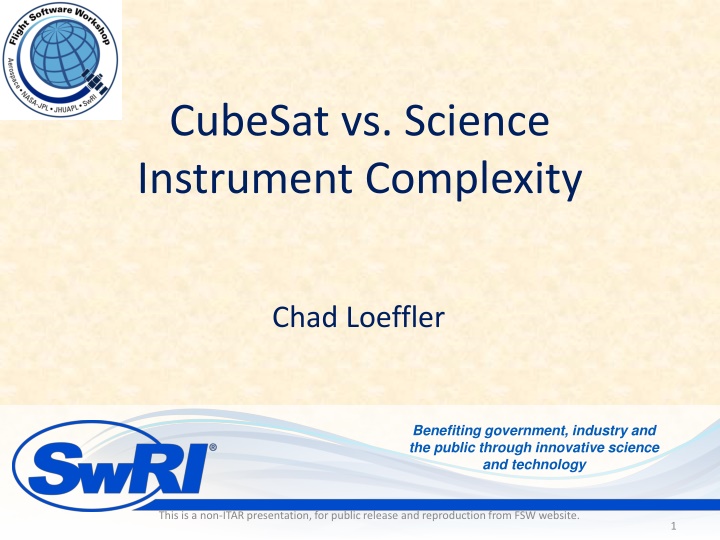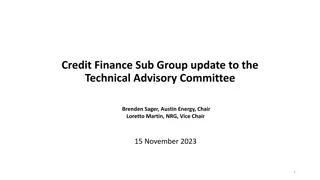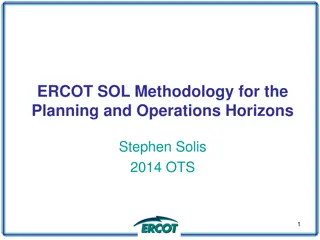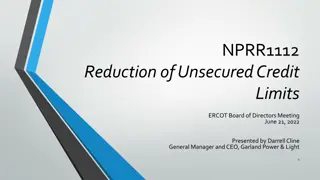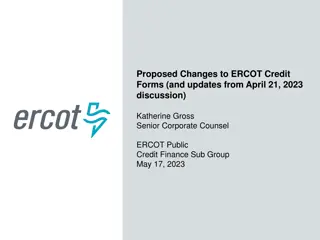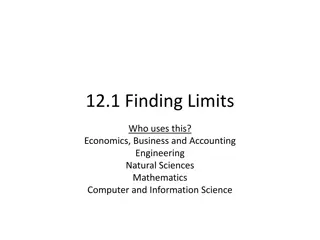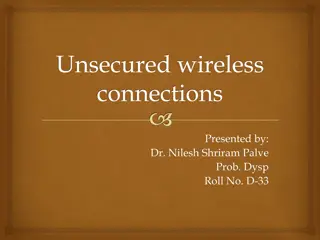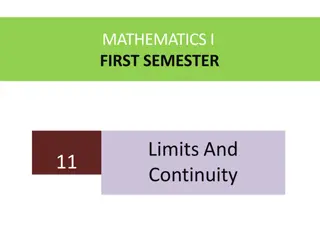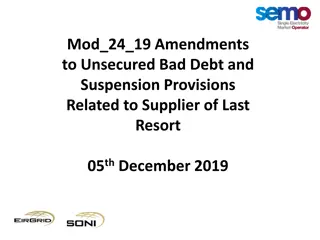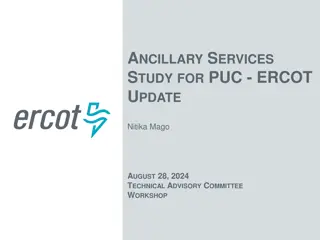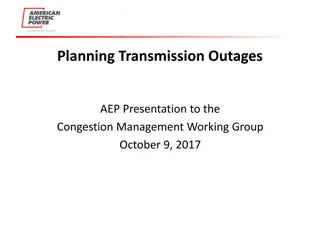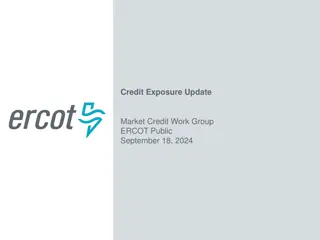ERCOT Report on NPRR1112 - Reduction of Unsecured Credit Limits
ERCOT's report discusses the impact of the CFTC RTO/ISO Exemption Order on unsecured credit limits, highlighting the disallowance of using unsecured credit for certain transactions and the reduction of caps to $50 million. The report also emphasizes the individual counter-party unsecured credit limits and practices of various ISO/RTOs.
Uploaded on Apr 12, 2025 | 0 Views
Download Presentation

Please find below an Image/Link to download the presentation.
The content on the website is provided AS IS for your information and personal use only. It may not be sold, licensed, or shared on other websites without obtaining consent from the author.If you encounter any issues during the download, it is possible that the publisher has removed the file from their server.
You are allowed to download the files provided on this website for personal or commercial use, subject to the condition that they are used lawfully. All files are the property of their respective owners.
The content on the website is provided AS IS for your information and personal use only. It may not be sold, licensed, or shared on other websites without obtaining consent from the author.
E N D
Presentation Transcript
CubeSat vs. Science Instrument Complexity Chad Loeffler Benefiting government, industry and the public through innovative science and technology This is a non-ITAR presentation, for public release and reproduction from FSW website. 1
Topics Introduction Processor Boards and Software Operations Fault Management Testing Stakes Of Destruction Conclusion Benefiting government, industry and the public through innovative science and technology This is a non-ITAR presentation, for public release and reproduction from FSW website. 2
Introduction Are low-budget CubeSats more complex than science instruments? Are they more similar or more different than expected? Two instruments are compared to two satellites: SO-HIS (science instrument) JUNO-JADE (science instrument) CUSP (CubeSat) CYGNSS (SmallSat) Benefiting government, industry and the public through innovative science and technology This is a non-ITAR presentation, for public release and reproduction from FSW website. 3
Processor Boards and Software JUNO-JADE (science instrument) 4 MB SRAM, 0.5 MB EEPROM, 24 MHz CPU SO-HIS (science instrument) 16 MB SRAM, 2 MB MRAM, 25 MHz and 50 MHz CPU CUSP (CubeSat) 4 MB SRAM, 2 MB MRAM, 4 GB FLASH, 50 MHz CPU CYGNSS (SmallSat) 4 MB SRAM, 4 MB MRAM, 4 GB FLASH, 25 MHz CPU Benefiting government, industry and the public through innovative science and technology This is a non-ITAR presentation, for public release and reproduction from FSW website. 4
Operations Science Instruments Receive commands and send telemetry Perform fault management and detection Collect and process science data, including use of high-voltage Operations Planning only has to handle reactions to thruster firings and orbit change maneuvers, not how to accomplish them Operations Planning only has to focus on data production to mass memory, not on storage and downlink to ground Usually no heater control Benefiting government, industry and the public through innovative science and technology This is a non-ITAR presentation, for public release and reproduction from FSW website. 5
Operations CubeSats and SmallSats Control radio for uplink and downlink Process commands and telemetry Perform fault management and detection Perform thruster firings and orbit change maneuvers Perform ADCS pointing and stability Maintain heater control for all components Maintain power levels and battery charging Store all data in mass memory, handle partitioning and downlink Benefiting government, industry and the public through innovative science and technology This is a non-ITAR presentation, for public release and reproduction from FSW website. 6
Fault Management Science Instruments Isolate faults to lowest level If fault is contained completely within a single sensor, but has multiple sensors, then can remain in science mode with unaffected sensors For off-nominal but not critically dangerous faults, when isolation of a component is not possible, then stay in Safe Mode No high voltage No science data collection No power to sensors For critical or dangerous faults, send Power-Off request to spacecraft Benefiting government, industry and the public through innovative science and technology This is a non-ITAR presentation, for public release and reproduction from FSW website. 7
Fault Management CubeSats and SmallSats Fail Operational instead of Fail Safe Most components, except for the payload, are critical and must remain operational, even if only in a minimal capacity Communications Radio Power System ADCS (Attitude Determination and Control System) and Thrusters Faults usually result in payload instruments being powered off Safe Mode means Sun-pointing instead of Earth-pointing Benefiting government, industry and the public through innovative science and technology This is a non-ITAR presentation, for public release and reproduction from FSW website. 8
Testing and Integration Science Instruments Test with a single spacecraft interface simulator or emulator Minimal external interfaces, either to the spacecraft or component between instrument and spacecraft Can have multiple internal interfaces, possibly with different protocols Sensors and detectors go through science calibration beam testing Benefiting government, industry and the public through innovative science and technology This is a non-ITAR presentation, for public release and reproduction from FSW website. 9
Testing and Integration CubeSats and SmallSats Test with multiple instrument interface simulators or emulators Test with multiple spacecraft component interface simulators or emulators Many interfaces Each payload instrument ADCS (Attitude Determination and Control System) and Thrusters Power System Communications Radio Each interface may have different software or hardware protocols Benefiting government, industry and the public through innovative science and technology This is a non-ITAR presentation, for public release and reproduction from FSW website. 10
Stakes Of Destruction Science Instruments Overwrite non-volatile memory with junk data and have no software to run Improperly use high-voltage and cause loss of science capability in sensors and detectors Low-voltage short-circuit in main electronics or non-switched component Mass produce too much data and fill up spacecraft mass memory (with caveats) Benefiting government, industry and the public through innovative science and technology This is a non-ITAR presentation, for public release and reproduction from FSW website. 11
Stakes Of Destruction Science Instruments A properly isolated science instrument can only end in its own destruction, not impacting the spacecraft or other science instruments Usually draws power from a switched source and has limiting or monitoring on power input Usually limited in mass-memory partition size and cannot overwrite other instruments buffers Can only cause mission end if not completely isolated from spacecraft and other science instruments, sharing power circuits or memory partitions Benefiting government, industry and the public through innovative science and technology This is a non-ITAR presentation, for public release and reproduction from FSW website. 12
Stakes Of Destruction CubeSats and SmallSats Failure to deploy solar panel arrays and start battery charging Failure to de-tumble and stop spinning Enable maximum power draw and point away from sun Fire thrusters too long or too little and change attitude or orbit Overwrite non-volatile memory with junk data and have no software to run Low-voltage short-circuit in main electronics or non-switched component Benefiting government, industry and the public through innovative science and technology This is a non-ITAR presentation, for public release and reproduction from FSW website. 13
Stakes Of Destruction CubeSats and SmallSats Unrecoverable faults in hardware and software can lead to mission end, either in loss of spacecraft or loss of payload Benefiting government, industry and the public through innovative science and technology This is a non-ITAR presentation, for public release and reproduction from FSW website. 14
Conclusion Stakes are higher for the CubeSat: loss of mission vs loss of single instrument. Complexity of operations, fault management, and testing is higher for the CubeSat. FSW processing needs are similar, such that similar or common processing board architectures can be used. Benefiting government, industry and the public through innovative science and technology This is a non-ITAR presentation, for public release and reproduction from FSW website. 15
